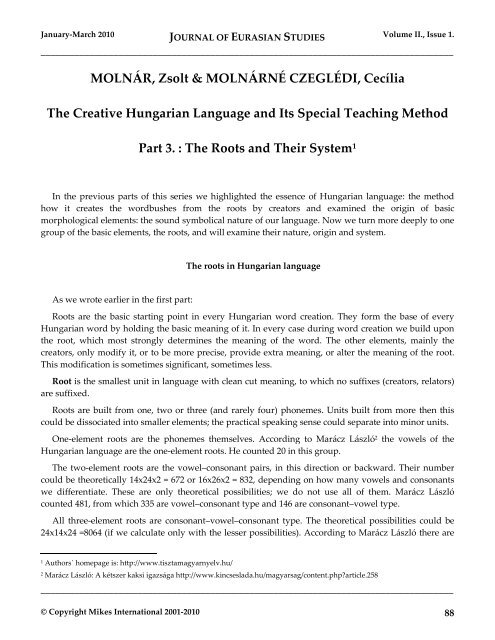EurasianStudies_0110..
EurasianStudies_0110..
EurasianStudies_0110..
You also want an ePaper? Increase the reach of your titles
YUMPU automatically turns print PDFs into web optimized ePapers that Google loves.
January-March 2010 JOURNAL OF EURASIAN STUDIES Volume II., Issue 1.<br />
_____________________________________________________________________________________<br />
MOLNÁR, Zsolt & MOLNÁRNÉ CZEGLÉDI, Cecília<br />
The Creative Hungarian Language and Its Special Teaching Method<br />
Part 3. : The Roots and Their System 1<br />
In the previous parts of this series we highlighted the essence of Hungarian language: the method<br />
how it creates the wordbushes from the roots by creators and examined the origin of basic<br />
morphological elements: the sound symbolical nature of our language. Now we turn more deeply to one<br />
group of the basic elements, the roots, and will examine their nature, origin and system.<br />
As we wrote earlier in the first part:<br />
The roots in Hungarian language<br />
Roots are the basic starting point in every Hungarian word creation. They form the base of every<br />
Hungarian word by holding the basic meaning of it. In every case during word creation we build upon<br />
the root, which most strongly determines the meaning of the word. The other elements, mainly the<br />
creators, only modify it, or to be more precise, provide extra meaning, or alter the meaning of the root.<br />
This modification is sometimes significant, sometimes less.<br />
Root is the smallest unit in language with clean cut meaning, to which no suffixes (creators, relators)<br />
are suffixed.<br />
Roots are built from one, two or three (and rarely four) phonemes. Units built from more then this<br />
could be dissociated into smaller elements; the practical speaking sense could separate into minor units.<br />
One-element roots are the phonemes themselves. According to Marácz László 2 the vowels of the<br />
Hungarian language are the one-element roots. He counted 20 in this group.<br />
The two-element roots are the vowel–consonant pairs, in this direction or backward. Their number<br />
could be theoretically 14x24x2 = 672 or 16x26x2 = 832, depending on how many vowels and consonants<br />
we differentiate. These are only theoretical possibilities; we do not use all of them. Marácz László<br />
counted 481, from which 335 are vowel–consonant type and 146 are consonant–vowel type.<br />
All three-element roots are consonant–vowel–consonant type. The theoretical possibilities could be<br />
24x14x24 =8064 (if we calculate only with the lesser possibilities). According to Marácz László there are<br />
1 Authors´ homepage is: http://www.tisztamagyarnyelv.hu/<br />
2 Marácz László: A kétszer kaksi igazsága http://www.kincseslada.hu/magyarsag/content.php?article.258<br />
_____________________________________________________________________________________<br />
© Copyright Mikes International 2001-2010 88

















